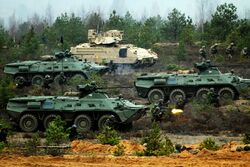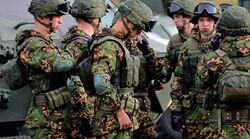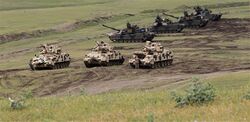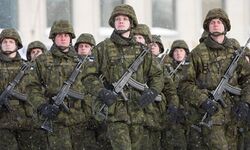Military of Florencia
| Union Defense Forces | |
|---|---|
 Banner of the UDF | |
| Motto | "In Defense of the Motherland" |
| Founded | 1866 |
| Current form | 1920 |
| Service branches |
|
| Headquarters | The Citadel, Saint Vera, Florencia |
| Leadership | |
| Supreme Commander in Chief of the UDF | Chancellor Maxim K. Tyrol |
| Secretary of the War Department | Chessa Impala |
| Personnel | |
| Military age | 17 |
| Conscription | 6 months minimum; varies by job |
| Available for military service | 12 million, age 17-50 (2019) |
| Reaching military age annually | 2 million (2019) |
| Active personnel | 1.2 million active personnel |
| Reserve personnel | 2.2 million organized reserves 7 million unorganized reserves |
| Expenditure | |
| Budget | $249 billion |
| Percent of GDP | 3.5% |
| Industry | |
| Domestic suppliers | Florencia |
| Foreign suppliers | Zhenia |
The Florencian military is at the forefront of the world's armed forces, it is a well oiled, well motivated machine fueled by an extensive military-industrial complex. The Chancellor is the Supreme Commander-in-Chief of the Union Defense Forces (UDF), National Militia (NM), and Scarlet Guards (SG). Together they are among some of the best equipped and well motivated armies in the world.
Military spending is a major aspect of the Union budget, typically around 10% of the GDP is committed to the military. This large budget and a well dedicated arms industry contributes to a cutting edge air force, expanding navy, and robust land force equipped with the most modern small arms, armored vehicles, aviation assets, and naval vessels.
Command and Organization
The War Department (WoD) is an executive office within the cabinet charged with coordinating and supervising all agencies and functions of the Union concerned directly with national security and the military. Nominal administration of the military establishment is exercised by a civilian advisory board, the National Defense Committee—which includes the chief commissioner of the Commission for Security and Order, director of the Office of Strategic Services, directors of nationalized war industries, in addition to representatives and senators from the All-Union Congress with invested expertise in national defense. The Secretary of the War Department is the principle assistant to the Executive Council on all matters relating to the defense of the nation.
Operational authority of the War Department is invested with the Stavka High Command of the Military, the senior uniformed general staff of the armed forces. The chairman of the Stavka is the highest ranking and most senior officer within the Union military and operational commander-in-chief of the Union Defense Forces, National Militia, and the Scarlet Guards. The Chairman's authority of the military is second only to the Chancellor and All-Union Congress.
A popular misnomer in the Florencian public and military itself is colloquially referring to both the Stavka High Command and National Defense Committee collectively as the Stavka.
The National Defense Act of 1920 established the military system in its present form. Disparate imperial army regiments and revolutionary volunteer militias loyal to the provisional government where synthesized into a new military representing the goals of the revolution. The result was a tripartite system of All-Union, constituent republic, and mass militarized organizations—the Union Defense Forces, National Militia, and Republican Guard. These forces are further supplemented by border troops administered by the Department of Justice and internal troops under the Commission of Security and Order.
The military would have been rebuilt from the ground up with the ideology of the 1919 revolution imprinted into the fiber of a traditionally conservative and bourgeoisie orientated organization. Three values in particular would be paramount in the transformation of the Florencian military; an armed populace, universal conscription, and military democracy.
Imperial tyranny had sought to disarm an entire population so as to gain complete autocratic control, an armed nation thus has the right and responsibility to be a bulwark against reactionary oppression, both foreign and domestic. The right to bear arms in the Florencian Union is considered sacrosanct. Reservist militiamen are permitted to safely store appropriate ammunition and service weapons in their private homes, subject to a military audit of course.
The notion of an armed nation goes hand in hand with the universal conscription practiced by the UFSR. Every able bodied citizen that has turned 19 or graduated high school is expected to perform a year of service in the Standing Scarlet Guards. The constituent republic organized National Militia, the professional Union Defense Forces, federal managed reserves, and law enforcement agencies recruit volunteers who have graduated from the standing guards. Should a graduate not pursue a vocation in national security, they would be rolled in the Unorganized Scarlet Guards and be free to pursue their life as a civilian, subject to yearly refresher courses or training exercises. Should a citizen be a conscious objector or be unfit for national service would perform alternate, charity, or auxiliary work for a full year.
The ideology of democracy was a leading factor for the revolution and like how such values revolutionized Florencian civil society, so did democracy transform the military. The UFSR is unique in it's commitment to military democracy: soldiers's councils, elections of NCO's, and a less rigid code of military discipline characterize this democratic process.
The Union Defense Forces (UDF) is the professional standing military of the UFSR and consists of two branches and four independent armed services: the Union Army, Union Navy, Union Strategic Weapons Command, the Air Defense Forces of the Homeland, the All-Union Marine Corps, and the Union Stellar Forces Command. A byproduct of revolutionary values places the structure of the active professional armed forces separate of the massed reservist levy force in the form of the Scarlet Guards. However given the sole focus of the Scarlet Guard as a ground militia contingent, both the Union Air Defense Forces and Union Navy organize reservist formations with a pool of former airmen and sailors.
Branches
Union Army
Born from the fires of revolution, the Union Army is the oldest, largest, and most diversified branch within the Union Defense Forces. In many ways the Union Army is a microcosm of the rest of the Defense Forces, with their own rocketry troops, air defense troops, aircraft, and paratroopers. Originally a loose grouping of patriotic rebels resisting tyranny, the army has grown exponentially in terms of size and power. The mission of the Army is the defense of Florence's people and territory on the land and air. To fulfill this mission the army maintains extensive commands, deploys a wide range of weapons and vehicles, and makes a great use of special purpose troops.
The Union Army does not administer a reservist formation directly subordinate to it, no doubt because of the extensive conscripted formations in the armed masses plus voluntary National Militia. For all intents and purposes the Scarlet Guards and constituent republican ran National Militias are de facto organized as the reservist formation of the Union Army. Replacements from the guards would replenish regular army units during wartime, national militia units operate alongside their active counterparts, and all forces ultimately fall under operational authority to the Stavka.
For administrative purposes the Union Army is divided into the Army Ground Forces (training and procurement of combat troops and equipment) and Army Rear Forces (rear support services that provide the material, infrastructure, and other miscellaneous services) while two other major autonomous services stands out: the Union Army Air Forces and the Airborne Troops.
The aerial warfare component, the Union Army Air Forces are tasked with the overall administration of the military's principle air force in support of the Army Ground Forces. The debate over the future of the air force within the Defense Forces led to the fracturing of the independent air force and the re-acquisition of frontal, long range, and material aviation responsibility by the army air forces. An extensive fleet of attack planes, multi-role fighters, swept-wind or four engine turboprop bombers, light and heavy transport movers, and rotary assets fall under the administration of the Union Army Air Forces, in addition to self propelled artillery anti-air assets. The air forces wield aerial mastery over the front line and beyond in support of the ground forces.
Well motivated volunteers with superior training, the Airborne Troops are some of the best troops in the army. Union paratroopers have no reason to be envious of their "straight legged" infantry counterparts when it comes to sheer firepower. Mechanized light armor enable Florencian "paras" a much greater deal of mobility over their foreign counterparts, at the same providing the airborne a lighter vessel for wrecking the same amount of destruction regular motorized infantry can wrought. Ferocious mobile assault troops or specialized rapid deployable paratroopers, the airborne is the Union Army's premier shock force.
Independent Arms of Service
Union Strategic Weapons Command
Air Defense Forces of the Homeland
The Air Defense Forces took to its redefined mission after the dissolution of the independent air force brancb with great vigor and dedicated its assets to the job of fighter, bomber, and missile interception. The branch comprises three specialized types of troops to provide for the anti-air defense of Union territory. That being the Radio-technical troops, Anti-Air Defense roops, and Fighter Aviation (FA). The principle role of UADF is the interception of enemy bomber forces should they penetrate Union airspace, or intercontinental ballistic missiles on a trajectory for Florencian cities. The Air Defense Corps deploys heavy interceptors, extensively organized SAM sites, and an encompassing expansive radar array for the defense of Union air space.
All-Union Marine Corps
The expeditionary wing of the Defense Forces. The Florencian marines are built around flexible combined arms formations that enable them to conduct seaborne landings and seize hostile territory from sea. By utilizing the sea-lift capability of the Navy the Marine Service is able to operate far from Union shores and respond to emergencies quicker than their Army counterparts. Also charged with both the defense of the Navy vessels and installations on land and sea. Perhaps most known for their unique "esprit de corps", ferociousness in combat, and vulgarity.
Union Stellar Forces Command
The National Militia
Army National Militia
Army Air National Militia
The Scarlet Guards
The Scarlet Guards were formed as an integral part of the Florencian Total National Defense doctrine. It is an entirely separate entity from the Union Defense Forces, but still subordinate to the Department of War and thus the Stavka. During times of peace the Scarlet Guards are organized into regional training brigades where able bodied Florencians of both genders fulfill their service commitment to the state. Draftees in the Scarlet Guard are thus seventeen, eighteen, or nineteen years of age and fresh out of secondary school or slightly older and just now in service to the state after receiving a waver for higher education. Recruits into the guard realize a contract of either six, nine, or twelve months to the state. Service length varies considering the amount of technical training needed in what job a draftee pursues.
During their time in the Scarlet Guard a recruit undergoes basic combat training, basic individual job training, partakes in training exercises, and can be in-bedded with the Union Army for technical job experience. The secondary peacetime role of the guard is to act as a work corps and community outreach program. After completing their basic training, a Scarlet Guardsmen can expect to find themselves in the outdoors for weeks at a time during a field training exercise, and then return to civilization to partake in road construction or working within an elderly town home. The conservation and development of Florencia's natural resources along with social work in educational, agricultural, and community programs is paramount to the mission of the guards. And lastly during times of natural disasters Scarlet Guardsmen from the closest training brigade would be among the first arrivals at the scene. In this way the Scarlet Guard acts as not only a conduit for producing a competent rifleman, but also instilling a sense of service to the commonwealth of the Union that isn't just taking up arms for her.
Between 3 and 7 million Florencians between the ages of 17 and 45 could theoretically be called up to fight under Scarlet Guard command as irregular or guerrilla forces in wartime. Those recruits who have finished their training and service and choose not to pursue a vocation in the professional defense forces are enrolled in the inactive Unorganized Scarlet Guards. Subject to yearly training call ups or exercises of course. In peacetime, however, about 1,400,000 drafted guardsmen are involved in training or other activities in what is known as the Standing Scarlet Guard. The duties expected to be carried out by the Scarlet Guard in the event of war are as follows: to be a secondary defense force in the event of invasion, to guard the homeland and free up posts for the Defense Forces overseas, and to act as a guerrilla force in the enemy rear should portions of Florencia be occupied.
Given the mass levy composition of the guards, the organization focuses on easily managed lightly armed infantry units who would be fighting on familiar local terrain. A typical unit is a company or battalion sized detachment. More than 50,000 communities, factories, clubs, universities, and other enterprises organize such units, which would fight in their home areas and thus defending local production complexes essential to the national effort.
The Scarlet Guards are highly decentralized and independent. Guard units are organized and funded by the governments in each of Florencia's constituent social republics, and then at the local level in cities, counties, or chartered by private enterprises.
Office of Strategic Services to the Stavka
The OSS is directly an independent uniformed intelligence gathering and covert espionage apparatus subordinated directly to the Stavka High Command. Despite being apart of the military establishment the service essentially acts as the virtual foreign intelligence service for the whole of the Union government. Uniformed members of the OSS range from deep cover special agents to militarized special purpose operations teams. Responsibilities include more wartime orientated duties such as sabotage, subversion, use of propaganda and any other actives under the umbrella of espionage. Most recently this has included the training of foreign paramilitaries. More wartime orientated activities include the covert surveillance of enemy forces during wartime or commando like operations conducted by OSS special purpose troops. The OSS maintains an extensive amount of spetsnaz reconnaissance groups that largely perform similar roles to their army counterparts. However Union Army Diversionary Troops are primarily concerned with wrecking havoc behind enemy lines, whereas OSS Spetsnaz is more so focused on gathering intelligence and eliminating high valued targets.
In practice with Florencian maskirovka ideology, very little is publicized about the Office of Strategic Services. The size and general scope of the military intelligence collecting branch is kept vague and secretive for a reason. It is speculated that there are OSS operatives serving in nearly every corner of the globe. It can also be reasonably theorized that OSS penetration of foreign nations is so extensive that hidden caches of weapons lie in wait, ready to be used by spetsnaz or foreign guerrillas. The extent and validity of such hearsay is difficult to discern.
Combined Special Operations Center — 450th OSS Special Purpose Group — Union Army: 1st Special Combat Applications Regiment (1st-SCAR/Jessie Scouts) "Saturn Group" — Union Navy: 42nd Naval Special Reconnaissance Detachment "Cascade Group"
The most elite tier one group of operators in the Union belong to the Office of Strategic Service's own spetsnaz Saturn and Cascade. Both groups are the premier special forces of the Union and specialize in hostage rescue, special reconnaissance, direct action, and assassination. While both groups perform the same missions and have the same operational capabilities, the culture of both groups are completely different. Saturn Group recruits exclusively from the army's diversionary troops, whose operators are already veterans of conflict and have several years of experience under their belt. Cascade Group is comprised of a mixture of OSS and navy spetsnaz operators who are fresh out of training and the top of their class.
Disposition of Forces
Reserve Mobilization
Class A
Class A divisions are active duty formations at peak authorized strength and feature fully equipped volunteers with up-to-date equipment. In the event of mobilization such formations can be readily made available, deployment time reliant only on orders received and the mobility of the division.
Class B
Class B divisions are National Militia formations that feature a full compliment of officers and a cadre of enlisted to maintain equipment. In the event of war, reservists from the National Militia will be mobilized to bring the division to peak authorized strength, with additional training. Equipment and training within Class B divisions are nominally on par with their A counterparts.
Class C
Class C divisions are bare bone formations featuring active duty officers only. During times of war it will take some time for a Class C division to intake mobilized conscripts from the Scarlet Guards, yet time is cut down significantly with a divisional command structure. Of course arms and equipment need to be procured for the division before it can be deployed or conduct meaningful training exercises.
Invisible Divisions
In the spirit of the well ingrained doctrine of maskirovka, a number of "invisible divisions" exist within the Union Army. In peacetime most every divisional staff has duplicates for such position as divisional deputy commander and regimental. One of these deputies performs his responsibilities and assigned tasks on the daily accordingly. The duplicate performs his deputy commander positions to the best of his ability but rarely, because he has other responsibilities. For instance, the second divisional commander deputy has the hushed role of "Divisional Commander—Second Formation". A similar arrangement exists with the chief of staff and regimental commanders, and every battalion commander's own deputy has the additional task of performing his superior's job.
In the event of war, the division will receive its orders from Stavka, mobilize, and head towards the front. However the duplicate junior officers have remained in camp and the battalion commander deputies have been replaced by a company commander (for there are not two junior battalion commanders), and he by a platoon commander. The division heads to war, with a full complement of soldiers, officers, and equipment. Such inconsequential shuffling of officers does not reduce the combat efficiency of the division in any such way.
However, a cadre of officers have remained behind, those being the duplicate junior officers. An entire divisional command staff stands at the ready, but there is no division to command. The issue is soon rectified by the arrival of 13,000 reservists or conscripts to complement a full division. No doubt the fighting capabilities of such a hastily formed formation are inferior to that of the average fighting unit. But a conscripted mass of citizen-soldiers are built around a professional core of officers who have years of active duty experience as commanders or understudies to them. The question then arises, what is this division to be equipped with? The answer is simple, they use outdated equipment. Everything of military value that ends up being replaced or superseded by a newer model is passed down and eventually mothballed, but still kept in working condition. After a quick sprint of refreshing training, an entirely new division is ready to be sent to the front.
Of course no formal proof of such formations exist and very little knowledge of the extent and scope of these divisions, outside of the Union Army is present. OSS military intelligence has gone to great lengths to ensure the secrecy of such divisions remains very minimal to foreign governments. The purpose of these invisible divisions is two fold; the rapid procurement of a reasonable combat effective unit, and to always keep the enemy guessing. These phantom formations ensure that enemy intelligence will never be able to properly gauge the troop strength of Florencia nor even what units are being meet in combat.
General Purpose Unit Organization
Strategic Direction
Operational Group
An Operational Group is the highest tactical operating unit in the ground forces that, while not quite as standardized as a division, it still has a clearly delineated structure for a specific mission in different geographical areas and under various operational constraints. Operational groups typically feature subordinate divisions between the Union Army, National Militia, and territorial brigades of the Scarlet Guards; though the highest readiness units will be almost exclusively professional troops from the army. The command and control of an operational group is typically granted to a Lieutenant General.
All-Arms Operational Group
An all-arms operational group (though it is rarely referred to as one) is the basic field army component within the military ground forces. Such operational groups consist of two to four rifle divisions and one or two armored divisions, plus artillery, anti-air artillery, engineer, chemical defense, signal, intelligence, reconnaissance, armored, rotary, and rear echelon support units. The alteration of the number of rifle and tank divisions along with tube artillery and rocketry artillery support units determines if a group can operate in defensive or offensive roles.
Armored Group
Like the all-arms group, the armored operational group is a basic and essential component to any army group. And like the all-arms unit, the size and composition of an armored group differs depending on operational constraints and the geographical area. Typically an armored group deploys with two to four armored divisions with one or two infantry divisions, plus artillery, anti-air artillery, engineer, chemical defense, signal, intelligence, reconnaissance, rotary, and rear echelon support units. An armored army is slightly smaller than an all-arms group but features greater cross-country performance, maneuverability, and striking power in order to exploit operations deep into an enemy's rear.
Composite Air Strike Group
Numbered Air Group
Division
Divisions within the Union Army are for the most part standardized and simplified to maximize battlefield efficiency. The division is generally speaking the smallest organic arms unit and would be tactically subordinated to an army. A Major General will take charge of the formation and every division subscribes to the triangular combat maneuver regimental structure. Furthermore most every division retains a headquarters staff, artillery regiment, communications battalion, cavalry reconnaissance battalion, pioneer battalion, service battalion, aviation company, and an artillery anti-air battalion. National Militia divisions typically are organized identically to the TOE as the Union Army, but not always.
Rifle Division
The backbone of the Union ground forces is the rifle division. The Florencian rifle division is 13,000 soldiers arrayed into three maneuver regiments, one armored rifled (mechanized) and two motorized rifle. The main striking power of the armored rifle regiment lays in it's organic tank battalion, with the two mechanized battalions acting in support. Likewise the motorized regiments feature a mechanized battalion supported by two motorized battalions. The rifle division is the unsung hero, bearing the brunt of most fighting. Honorary epithets such as "Grenadier" or "Storm" may replace or supplement "rifle" as a morale-building honorific. Within militia rifle divisions the table of organization is always the same as that of the Union Army.
Eight Rifle Divisions are in service with the Union Army and the National Militia organizes four of them.
Light Division
The light divisions of the Union ground forces forgo the mechanized regiment organic to rifle divisions, instead opting for a third motor rifle maneuver regiment. Union Army light divisions also forgo the the mechanized battalion organic in a motorized regiment for another battalion transported via wheeled armored personal carriers. However some National Militia divisions retain the mechanized rifle battalion for all three maneuver regiments.
The light division is purposed to tackle vertical mountain warfare, high intensity urban missions, dense jungles, or water clogged marshes. Light infantrymen relay more so on marching through impassible ravines, skiing down alpine slopes, or fording through swamps as opposed to motorized transport. The Union's finest soldiers for any extreme or specialized environment. A battalion of light armored wheeled tank destroyers is tacked on for added firepower. National Militia light division table of organization typically forgo the tank destroyer battalion for a proper armored battalion All light divisions are given an environment specific designation, "Mountain" or "Jungle" for instance.
One light division is in service with the Union Army; the 19th Mountain Division. The Army National Militia reserve operates a further eight light divisions.
Armored Division
The armored divisions are the deep cutting sabers that emulate the cavalry of old. Meant to overwhelm the enemy with overwhelming firepower or simply race on past him, the armor is structured as two combat regiments of tanks and one of mechanized rifles. Armored regiments featuring two battalion of tanks supported by a mechanized battalion.
Armored divisions feature a leaner line up of 12,000 soldiers, which is of course offset by the greater concentration of armor, plus the addition of a motorized rocket artillery company. A commonality with the rifle division is that such honorifics as "Cavalry", "Dragoon", or "Hussar" can likewise be adopted. Militia armored division templates are typically the same, though an armored or armored rifle regiment can be forgone for just two combat maneuver regiments.
Currently the Union Army operates three of these divisions and the National Militia two.
Airborne Divisions
An airborne division is a much leaner formation as opposed to the rest of it's peers. With a strength of only 8,500 men, it has two maneuver regiments of parachutists, supplemented by an air deployable tank destroyer (or tank) battalion, and support units trimmed of excess. The Airborne Division is geared towards being a deep-penetration, almost guerrilla style fighting unit.
Whereas the airborne assault divisions of the Union Army are purposed towards being rapidly deployable and actually capturing and holding an objective. They are unique for their total mechanization utilizing light combat vehicles, leading to much greater combat mobility when compared to foreign counterparts. Given the nature of modern warfare a massed combat airdrop will not be completed, but mechanization and the extreme air mobility of the airborne assault forces ensures that they remain relevant as the Union Army's quick reaction force.
The Union Army currently has two airborne and two air assault divisions.
Regimental Combat Teams
Regimental Combat Teams are the smallest independent combat maneuver unit of the Union Army. These independent regiment are essentially reinforced combat regiments, with support, reconnaissance, and artillery elements. Regimental combat teams combine the unit cohesion of the standard regiment with accompanying reinforcements to provide greater firepower or flexibility to an army group. Independent regiments stand at an authorized strength of 4,000 soldiers and fall under the leadership of a Colonel.
Rifle Regimental Combat Team
A motorized infantry regiment reinforced by a wheeled or mechanized anti-tank battalion, along with all other typical reinforcements. Three of these regiments are organized under the Union Army and two by the National Militia. The independent rifle regiment typically act as environment specific units and are forward deployed by their respective strategic directions.
Armored Calvary Regimental Combat Team
The armored cavalry combat team is the Union Army's secondary armored force and is designed around a combined arms maneuver regiment supplemented by an additional reconnaissance cavalry group, armored rifle battalion, and artillery units. The Union army fields three of these regiments and the National Militia an additional one to augment operational group commanders with an independent reserve of heavy hitting armor.
Air Calvary Regimental Combat Team
The air assault component of the Union Army that deploy almost exclusively from aviation assets, quite smaller than most other separate regiments. The organic artillery battalion itself is omitted, so that motorized or towed howitzers can be replaced by dedicated helicopter gunships from the combat aviation group. The battlefield mobility of a reinforced regiment that is almost entirely transportable by way of rotary or VTOL assets is near endless. Air Calvary regiments are meant to act as an air mobile striking force for strategic direction commanders to seize strategic points such as bridges, airports, or industrial zones. There are currently six of these air assault regiments in the Union Army.



